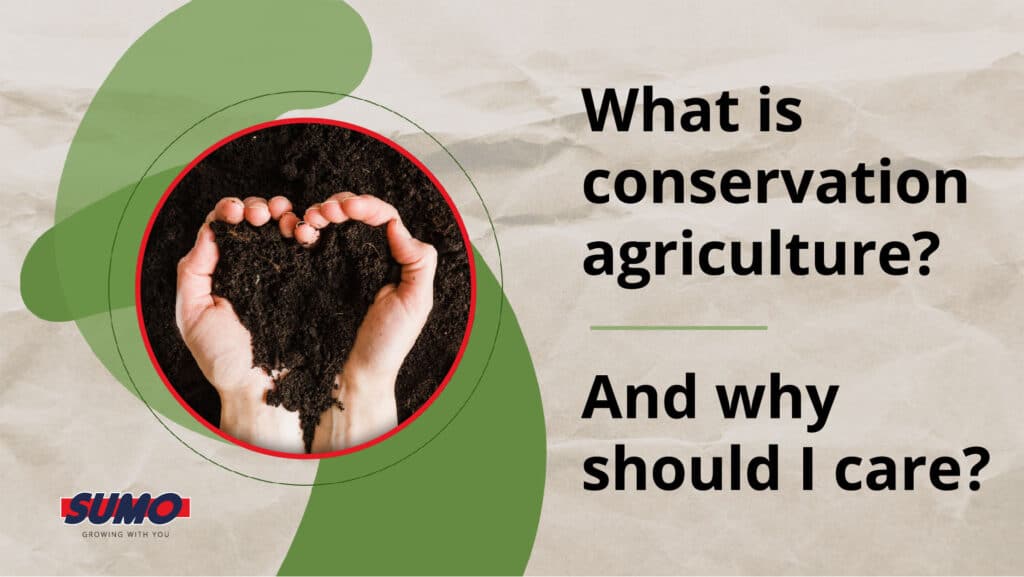What is conservation agriculture?
May 10th, 2021
With a lot of noise currently surrounding sustainability in British agriculture, there are many conflicting viewpoints on the best approach farmers should take to care for their environment.
In this blog, we discuss conservation agriculture, and how by looking after your soil, you’re looking after your bottom line. We explore how it can benefit farmers to increase yields and lower crop establishment input costs, as well as how it can fundamentally improve soil health and benefit the environment.
What is conservation agriculture?
Conservation agriculture is a farming system that puts soil at the centre of the farm universe. It can help protect the soil from erosion and degradation, improve soil biodiversity and protect our most precious natural resources, water, and air.
By looking after your soil, conservation agriculture methods are also thought to be able to help encourage crop establishment, lower input costs, and increase yields, so farmers are able to maximise margin potential increasing the bottom line too.
Why should I consider conservation agriculture?
Agriculture in the UK is currently going through a pivotal time. With the uncertainty of ELM’s, governmental policy, the goal of net zero and other market pressures, farmers are being encouraged to adopt sustainable practices.
Such practices include:
- Minimum or zero tillage
- Cover cropping
- Crop rotation
- Reduced fertiliser and chemical use
Traditional tillage methods and chemical controls have been commonplace in the sector for decades so newer, more sustainable practices can often be met with scepticism.
Conservation agriculture provides a practical solution to current pressures and allows farmers to slowly change their approach to crop establishment.
What are the benefits of conservation agriculture?
Conservation agriculture has many benefits including the reduction of input costs and improving soil quality and health.
Reduction of input costs
The reduction of input costs is one of the main benefits of conservation agriculture. Such methods can lead to savings on labour, fuel, and maintenance.
Minimum or zero tillage means soils are cultivated as little as possible which should help farmers to save time and reduce wear and tear on machinery.
In addition, focusing on soil health and organic matter should also mean there is a reduced need for inputs as soils are richer in the vital nutrients needed for healthy crop development.
Improved soil quality
The methods of conservation agriculture are known to help build soil organic matter through the continuation of multiple layers of crop residues.
With increased organic matter, soil structure and microflora and fauna will improve, reducing the need for synthetic fertilisers. This is because the microbiome of the soil is healthier, favouring a symbiotic relationship between plants and microbes which allows better utilisation of nutrients.
Soil aggregation is also improved. This is where soil molecules clump together, resulting in better water holding capacity and leading to further nutrient retention.
When all of this comes together there’s an improved rooting zone, leading to bigger yields.
On top of this, all of these impacts mean there‘s a reduced need for deep tillage so minimum tillage can be used practically and effectively.
Sumo and conservation agriculture
To support British farmers through conservation agriculture and the move from plough to minimum tillage, Sumo has developed a range of mounted tillage cultivators and drills that are ideal for small to medium sized farms.
All machinery is designed and manufactured in the UK to support soil structure and improve soil health.
Tillage cultivators include:
- Multipress – tine cultivator
- Mixidisc /S – disc cultivator
- LDS – low disturbance subsoiler
- Strake – straw rake
Drills include:
How can conservation agriculture help the environment?
If British agriculture is to achieve net zero, changing farming practices to be more in line with conservation agriculture is key. Conservation agriculture can help the environment by:
- Reducing soil erosion
- Improving water quality
- Improving air quality
- Increasing biodiversity
- Increasing carbon sequestration
When soils are in good condition as a result of conservation agriculture, rain will move through the soil with higher infiltration and reduced run off which results in less erosion.
Crop residues also protect the soil from wind, meaning soil moisture is retained.
Systems, based on high crop residue addition and minimum tillage, accumulate more carbon in the soil, compared to the loss into the atmosphere resulting from deep tillage.
Protecting soils will be vital for the future of agriculture in the UK, and conservation agriculture provides the tools to do just that, as well as helping farmers to achieve crop’s yield potential.
Moving towards a more sustainable system and away from deep tillage can take time to implement and feel like a big step. But, it’s possible to gradually transition towards conservation agriculture practices if you work closely with your team of advisers. The team at Sumo are available to advise on the transition towards modern tillage practices and can be contacted at info@sumo1.com for advice.



